![]() 1st Battalion 22nd Infantry
1st Battalion 22nd Infantry ![]()
Personal Recollections
of Cambodia
And Attack on LZ Valkyrie
By James Henderson B/1-22, 2nd Platoon
The Attack
A round robin type discussion concerning the events on LZ Valkyrie in the wee hours of 13May, 1970 has been conducted several times in the ensuing years. Among those who contributed to or edited this narrative include but is not limited to then Major Ronald Rabin, 1-22 Battalion Commanding Officer or CO, Tactical Operations Center, or TOC, and Radio Telephone Operators or RTO’S George Heidt, Tom Buhrkuhl, Wayne Wright, and Kerry Sheridan. TOC was what might be regarded as headquarters or the command center.……Russ Armstrong and Randy Fey from C Battery 4-42 Artillery…..Ray Rameriz from 4.2 mortars………from B Company on the bunker line Nick Coraggio, Fred Golladay, Gerald Patterson, Kim Bennett, James Killian, Richard Buenzle, and myself, James Henderson.
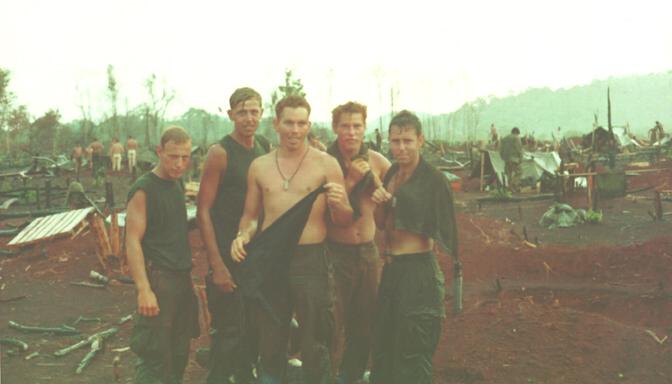
FSB Valkyrie, Cambodia, May 1970
TOC RTO's left to right: Kerry
Sheridan, Henry "Dutch" Veldman, Ronnie "Tex"
Fisher,
Steve
Johnson and Tom Buhrkuhl.
Photo courtesy of George Heidt
|
Left: Sergeant George Heidt Battalion S-2 (Intelligence) RTO Photo courtesy of George Heidt |
George was the driving force behind the e-mail round robin discussions mentioned above. He was the moderator and emcee of all the talks that went on. It wouldn’t have been possible to write this story without him.
On the nights leading up to the night of May 12th and the early hours of May 13th, Bravo Co, on the bunker line of LZ Valkyrie, observes flash lights and movement on several occasions. Employing M79 fire on one occasion.
On the early evening of 12 May, at 1730 hours, LZ Valkyrie receives sniper fire and the bunker line responds with small arm, M60 and M79 fire. First Platoon, Bravo Company is sent to check out the area, returning just before dark and reporting negative results. As darkness closes in on the night of 12-13 May, the stage is set.
Beginning in the early morning hours of May 13, at approximately 0330 hours, Valkyrie begins to receive mortar, small arms, Rocket Propelled Grenades, or RPG’s, and heavy machine gun fire. NVA sappers are observed attempting to breech the perimeter. According to the S-3 Logs, over the next hour or so, approximately 14 rounds of 82mm incoming mortar fire is received.
The sapper attack, it is generally agreed, was centered on the eastern side of the perimeter of LZ Valkyrie along the 3rd Platoons bunker line. Ground zero for the attack was at a bunker occupied by Nick Coraggio and other members of an M60 machine gun team. Nick was manning the M60 that night and was awarded a Bronze Star for Valor for his courageous actions and a Purple Heart for his wounds. Although the only confirmed enemy KIA’s at first light were two loin cloth clad sappers, Nick and others reported seeing uniform clad NVA armed with AK47’s. Thus, the exact size of the attacking force remains unknown.
Nick Coraggio
Photo courtesy of Fred Golladay
Nick recalls “Early in the evening on the 12th, I observed the raining illuminations and heard that Arty was using them up so they didn’t have to load them the next day, since we were leaving. I set the gun up just behind and to the side of the bunker, I laid some rows of 7.62’s, like folded ribbons, on a sandbag and loaded a hundred round starter belt into the M60. I had first or second guard (we didn’t have a radio), the illumination ended about 2200 or 2300 hours. I pull my guard and go to sleep”
The incoming barrage and the sapper attack happened virtually simultaneously. As Nick continued his narrative it seems that perhaps his opening up on the sappers was the catalyst that began the battle.
Nick says, “As I slept I heard a squad members voice, just as clear as if I were awake, say something like ‘who are you?’ and at that moment I somehow looked directly at two silhouettes walking not more than 20 feet away just in front of the bunker line, in-between the bunkers. Somehow, I immediately identified them as gooks, and I say “fire!” (As if to draw any initial fire at me away and get my gun so I could focus on a target). The attacker moved in front of the bunker using it for cover. I knelt behind and double checked my gun and waited for a target. I felt an itch on my thigh. I tried to put it out of my mind, but it persisted. I reach down to scratch it and my pants are wet. Suddenly I realize that I’d been shot (I had not seen any muzzle flashes nor heard any gunfire). Now as I still waited for a target, I felt something touching my forearm arm and hear a light thud on the ground. At that very moment I put two and two together and figured something was going to explode. I took two leaps to the rear on my non-injured leg and covered my head with my arms. There was an explosion, definitely not a mortar round, I didn’t feel the concussion nor are my ears ringing. I hurry back to the gun, as I get there, I notice I’m all lit up, it’s my poncho liner, it’s on fire, I put it out.”
Whether this explosion was the first start of the attack or whether there were already impacting mortar rounds near TOC and the Arty Battery is difficult to say. In any event from this point on things livened up considerably.
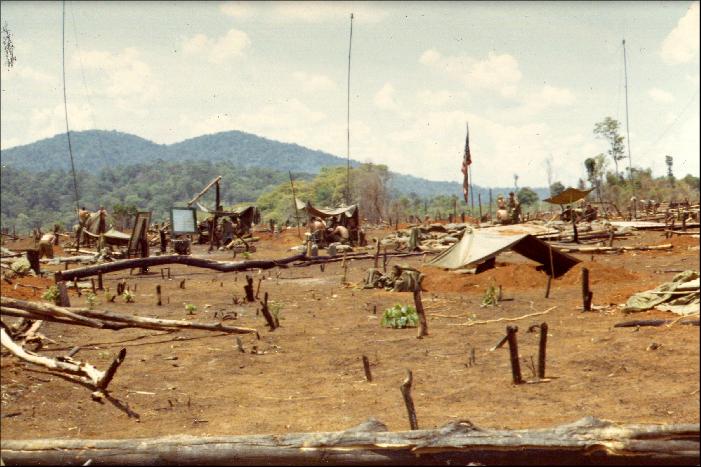
FSB Valkyrie TOC, first couple days of firebase construction. - Cambodia May 1970
Photo courtesy of Tom Buhrkuhl
Nick continued “I got back to the bunker and crouched behind my gun with my finger on the trigger. I see a shadow crawling at me along side the bunker. By now I’m starting to hurt more but that shadow was getting too close, so I cranked up that 60. I fired about half the starter belt, I don’t remember if I fired continuously or if I throttled back a couple of times briefly. As I again waited for a target, I got worried that I’d missed so I fire the rest of the belt, leaving enough to hook up to the ammo I had prepared earlier. I hooked it up and watched and waited.”
“Then from behind me I hear a voice say, ‘What’s going on?’ or something to that effect. It was Cpt Tijerina, he was standing in full view, by a mass of equipment, probably the 105 guns. It didn’t appear that he was sure we were under attack. I told him there were two gooks in front of the bunker. I asked if we could pull back and told him I needed a medic. He said wait and faded back into the darkness. My memory is a little weak on the order of the next events, or how much time elapsed but someone gave the OK to fall back. Everyone took off leaving me and my assistant gunner behind. I guess they didn’t realize I was wounded enough to affect my movement. I didn’t make it back; I had all that ammo on the sandbag and the M60. Finally, I get back. Here again, my memory is weak, but the Battalion surgeon shows up and applies a field dressing on my wound and tells me he doesn’t know if there will be room for me on the dust off, then he fades into the distance. They direct-fired the 105 on my bunker, the battalion surgeon returns, and they help me to the dust off.”
Note: what Nick referred to as “…direct-fired the 105 on my bunker…” involved lowering the 105 Howitzer tubes horizontal to the ground and loading it with what was called a beehive round, so named because it sounded like a swarm of bees going through the air and which each round contained more than 8,000 flechette darts. Each dart being roughly 1-2 inches in length and having a vaned tail for stable flight. What could be described as 8,000 finishing nails with fins. Extremely lethal, totally devastating, against infantry or sappers. The artillery battery fired 4 of these rounds in the direction of Nicks bunker, after evacuating everyone from the bunker area, of course.
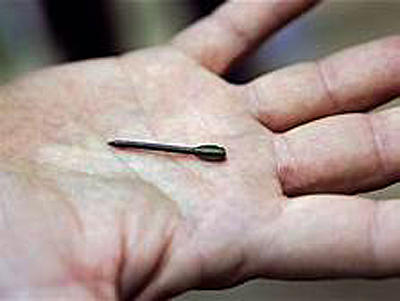
Flechette - 8,000 of these per 105 artillery round
Right: Captain Gil "TJ" Tijerina Commanding Officer of Company B Photo courtesy of Harry Beck |
|
As Nick and others are dusted off, he recalls “The flight was total darkness except for the lights on the dashboard. It didn’t seem as long as the flight that took us out. We land and someone and my squad member help me into a tent where I see a guy in boxer shorts and untied boots working on someone. I can’t remember how I got to the hospital, and it took hours before they operated on me and while I waited there was a dying enemy across from me. I worried that he might get up and kill me. Finally, he died. I was relieved.”
From dark until approximately midnight we had nearly continuous illumination rounds being fired, by our own C-4-42 artillery and mortars and from Charlie’s sister battery of A-4-42. Once the attack started, approximately 0330 on the 13th, we again began continuous illumination. Ray Ramirez, serving with the 4.2 mortars, recalls “I had already pulled my guard and was asleep when Vince Garcia, from our squad, came running in shouting ‘incoming !’ , at that point I could see the red flashes from the rounds as they impacted.” “After that we got the command to pop illumination, as they wanted constant illumination” “I ran outside to help and could hear the sounds of machine guns firing on the bunker line” “the illumination rounds were aimed toward the edge of the perimeter, I remember looking over my shoulder in the direction of the Artillery Battery and seeing the incoming rounds impacting”
The 4th Division Artillery Operational Report Lessons Learned lists 14 rounds of incoming mortars, however there was without a doubt satchel charges thrown by the sappers and several people thought there was also incoming B40 rocket fire. CPT Tijerina states that he recalls clearly seeing incoming B40 rocket trails that the NVA had fired in salvos. Tom Buhrkuhl, who was an RTO with TOC that night, recalls “We had the generator running and a light on in the TOC bunker. When the rounds started landing, I thought the light could provide a perfect aiming spot for the NVA or the sappers to be attracted to” “I pulled the light down because there was no switch to turn it off. This started a small fire in the wires that I put out with a towel. I later told the Commo LT that he needed to always put a switch on the light so that it could easily be extinguished.”
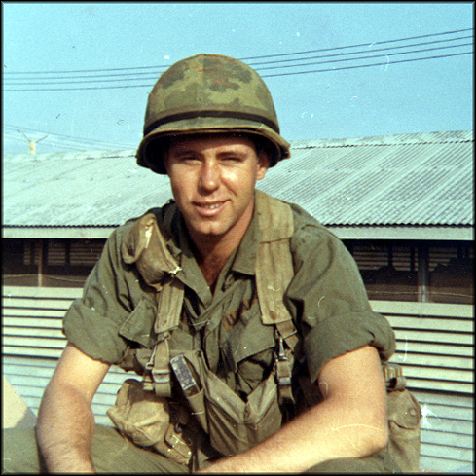
SGT Tom Buhrkuhl BN S-3 RTO, on truck at An Khe before heading for Cambodia
Photo courtesy of Tom Buhrkuhl
By most accounts the majority of the rounds landed in the center of the firebase, near the mortar pits, the artillery battery and the TOC. One of the 81mm mortar pits seemed to take a direct hit and was totally destroyed. Another RTO at TOC, Wayne Wright, recalls “I was in my bunker when the first mortar round hit, I took off toward the TOC and just as I got there another round hit and the guy guarding TOC said he got hit with some fragments, I pulled him in with me but don’t believe it was serious.” “I believe Major Rabin was already there, the firefight was going on as Ray described”.
|
Left: Wayne "Whiskey" Wright Artillery Liaison Officer RTO Photo courtesy of Wayne Wright |
Major Rabin, who later retired a Colonel, told me years later “One of the weird circumstances of our operational environment is that battle commanders, such as myself, could monitor radios and help troops on the ground like yourself, fight, win and survive, we could not see/experience the real battle. I found that unless it was a real goat cluster, that demanded my presence, it was best to let leaders like TJ run the operation without having to deal with distractions like me hovering around”
Tom adds “The closest round to us was the one that wounded the guy sitting on the radio bunker pulling security. I checked his wound and helped put a bandage on it. It was to the neck and not very serious, but he was one of the guys dusted off, I don’t remember his name.”
There were widely varying opinions of the volume of small arms fire from the wood line and several reports of heavy machine gun fire. The base was still very much in the early stages of construction, some bunkers had overhead, others did not. While most agree that parts of the base had a single strand of concertina, CPT Tijerina is adamant that there was no concertina wire, and certainly some areas had none. Concertina wire was razor sharp barb wire that was in expandable coils or rolls that might look somewhat like a slinky toy when pulled apart. The S-3 Logs of 11 May, at 0900 show that the “…….. 2nd Brigade Engineer Officer requests 5 or 6 pair of wire laying gloves …….” The S-3 Logs of 13 May say “………spotted outside the wire……two satchel charges thrown over the wire…..”. But, it is believed that 3rd platoon’s section had no wire and that this is possibly why that section was chosen, although this is pure speculation…..only the NVA know for sure why they chose that particular spot.
Myself, James Henderson, was on the bunker line with 2nd platoon in the southern part of the fire base. As I recall our bunker had the logs on it for overhead but no sandbags. Sgt Buenzle, our squad leader, was sleeping on top of the bunker that night on his air mattress. When the attack started, he remembers small arms rounds coming in directly over him and he rolled off the top of the bunker to get inside. It seems to me that we had some form of wire in front of our position, even though it may have only been one strand of concertina. From the get-go, we always had full coverage with trip flares and Claymore Mines, with or without concertina. It was a reasonably far distance to the wood line in front of our bunker, far enough that we had good fields of fire, maybe 50-100 yards. When illumination rounds were being fired, we could see clearly.
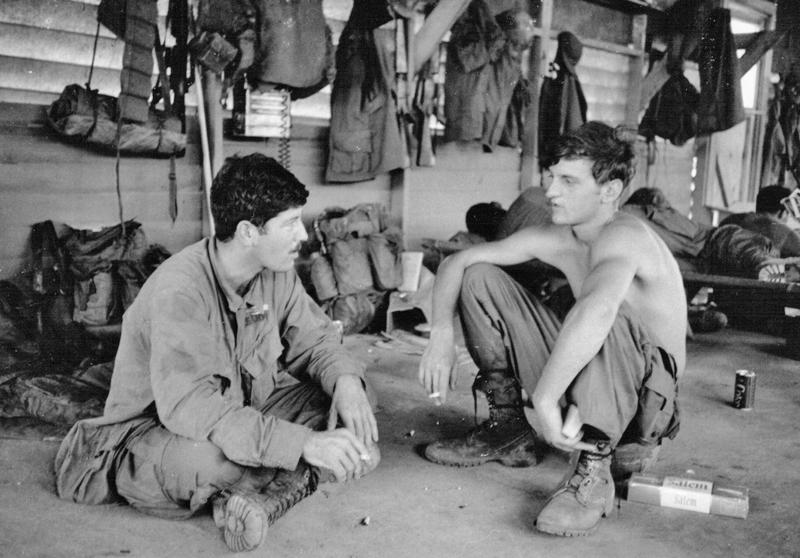
Richard Buenzle on left, and James Henderson on right, in base camp prior to going into Cambodia
There was what I believe to be a heavy machine gun, 51 cal, on a wooded hill to my right front, in a southwesterly direction. It was firing more towards my right, towards the west side of the fire base and in the direction of 1st Platoon’s side of the perimeter. I remember being fascinated at the stream of green tracers and the distance they were coming from, far out of M60 or M16 range. I snapped out of my trance and got my head down when I realized the tracers seemed to be walking back in my direction, although I don’t think the NVA gunner ever intentionally walked it as far as our bunker.
At some point, when Cpt Tijerina realizes we actually have gooks inside the perimeter, he gives the order for everyone to stay in their bunkers, as he’s afraid we’ll shoot each other firing back and forth across the perimeter. I can’t recall if we had a radio, and the order came over the radio or if it was relayed to us. From this point on we have continual illumination, and we simply stay in the bunker watching our fields of fire. There was never any sapper activity in our section, but we could hear the rounds impacting and the firing to our rear.
Jim Killian was a member of Jesse Johnson’s M60 machine gun team. Their team was to our immediate left or maybe you would say towards the northeast, between us and 3rd platoon. Jim recalls that they had removed whatever overhead protection they had with the knowledge that we were abandoning the firebase the next morning. Jim was sleeping in a one-man prone fighting position out in the open by himself. He said that while he never had any action in his direct vicinity, it was disconcerting to have the action so close to his left side, further north, and with him being alone by himself out in the open.
Right: Jim Killian in An Khe on stand
down Photo courtesy of Jim Killian |
|
According to the Logs there were 11 US WIA, and at 0340 5 WIA were dusted off, 4 blue leg (Infantry) and 1 red leg (Artillery) and one US KIA.
At 0455 an internal perimeter sweep found 2 sappers KIA one with his satchel charge still on him. At 0650 3rd Platoon goes 50 meters into the wood line, finds several hootches and recons by fire.
Home | Photos | Battles & History | Current |
Rosters & Reports | Medal of Honor | Killed
in Action |
Personnel Locator | Commanders | Station
List | Campaigns |
Honors | Insignia & Memorabilia | 4-42
Artillery | Taps |
What's New | Editorial | Links |